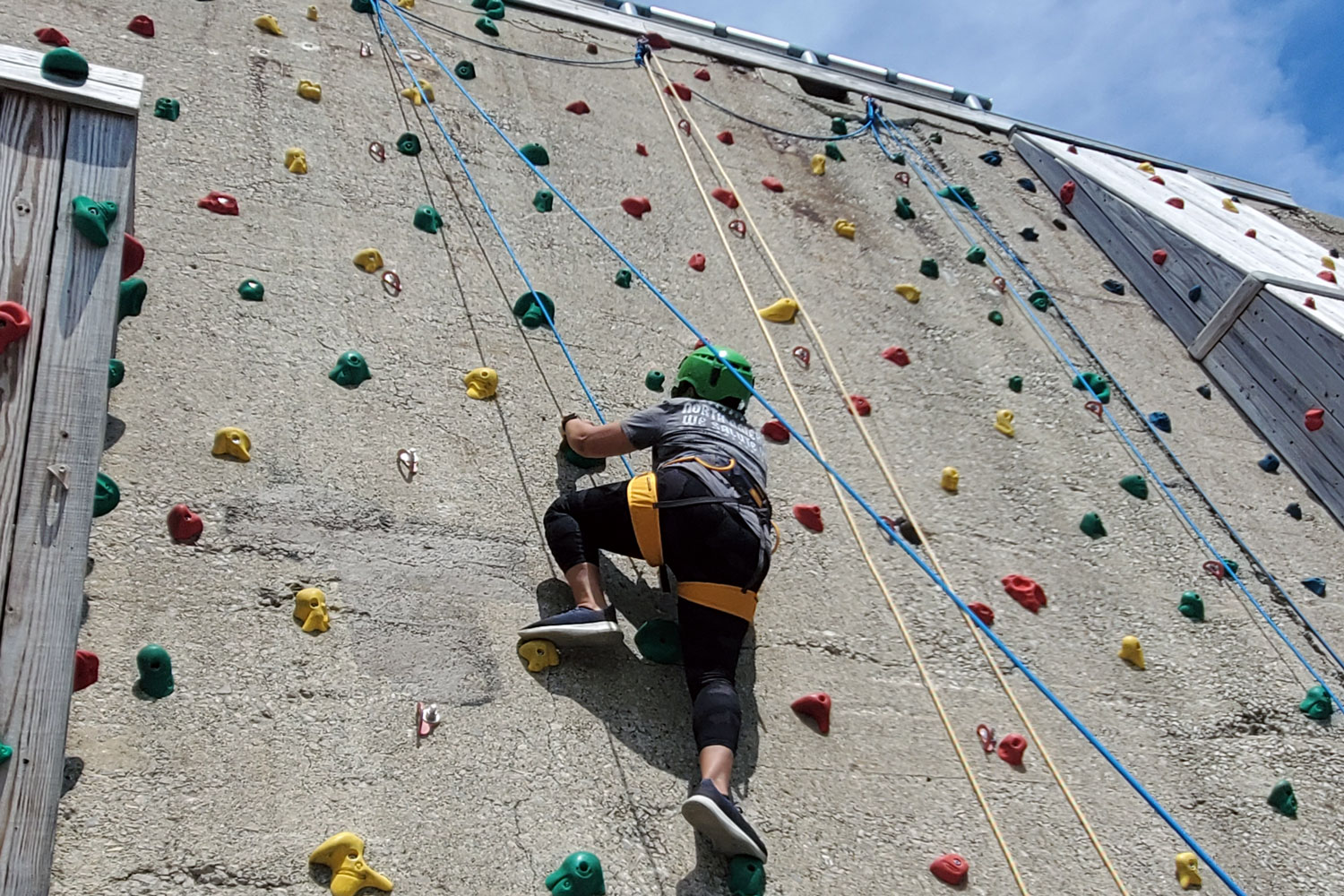I was halfway up the climbing wall at Steelworkers Park when I thought, “Why the hell am I doing this? If I want to get to the top of a 30-foot wall, wouldn’t it be easier to use a…ladder, or a…cherry picker?”
Nevertheless, I persisted. People were watching from the ground. I didn’t want to look like a coward, or a quitter. This was my first ascent on a climbing wall. My seven-year-old daughter has climbed before. She gave me this advice: “Just don’t be afraid, and you’ll be OK.” So I extended my leg toward the next foothold, a plastic lump labeled Groperz that was affixed to the concrete, and hoisted myself skyward. When I finally grasped the highest Groperz, my spotter began rappelling me back to Earth. I skinned my knees because I was afraid to let go of the wall.
“Lean back!,” my spotter shouted. “Pretend you’re sitting in a chair!”
My spotter’s name was Laura Statesir, of Chicago Adventure Therapy. When I had two feet on the ground again, I told Laura that, while clinging to the wall, I had thought of more efficient means of reaching the summit. Laura told me I was missing the point of rock climbing.
“It’s not about getting to the top,” she said. “It’s about the journey.”
Joel Zavala, who manages the wall for the Chicago Park District, provided a more literary justification for getting to the top of a wall, just to go back to the bottom again.
“Climbing is ‘the conquistadores of the nothing,’” Zavala said. “You get up there, and there’s up there. On the surface, it may seem that way, but there’s fears being conquered, comfort zones being expanded, trust in equipment, in yourself, in strangers, high school peer pressure all over again. Really, there’s a lot happening.”
Let’s talk also about the journey of this wall that I and 30 other people climbed last Saturday. It was built as one of two ore walls for the U.S. Steel South Works mill, to hold taconite pellets delivered by Great Lakes freighters. The ore walls are the last remnant of the mill, which once employed 20,000 steelworkers, but shut down operations 30 years ago. Two thousand feet long, they are mighty ruins. Ozymandian. Too big to tear down. Over the years, developers have drawn up plans to transform South Works into Chicago’s newest neighborhood, with tens of thousands of condominiums, office space, a shopping mall, and a Mariano’s supermarket. Emerald Living, an Irish developer, had a contract to buy the site for $64 million, but backed out in 2018, explaining that “[t]he industrial heritage of this site presented significant challenges.” Meaning that the soil, which rests on slag, is still polluted with the toxins of steelmaking.
Steelworkers Park, which opened in 2014, is South Works’s only re-use, so far. The climbing wall, constructed four years later, is the park’s most popular attraction. The site feels remote, with cicadas buzzing in the prairie grasses, and a breeze blowing off the lake, plied by a single sailboat, but it’s actually bringing climbing closer to a population that otherwise could not reach or afford it, Zavala said. The wall is always available for climbers who bring their own equipment, but one Saturday a month, the park district holds free Community Climbs from 10 a.m. to 1 p.m., providing shoes, harnesses, ropes and spotters. (The next date is September 17.)
“Most of the climbers are first-timers,” Zavala said. “That’s the audience I hope to get. The sport of climbing is not one you can get into easily. There aren’t climbing gyms in every neighborhood, and they’re expensive. This is free, and the demographic in the neighborhood may not be able to climb otherwise. Something like climbing isn’t accessible to everybody. I grew up in Little Village. My parents used to drive me to Dick’s in Lombard, and it was $20. That’s not accessible to everyone.”
Most climbers are South Siders. Eric Cervantes and Gloria Mendoza journeyed from Archer Heights, which has no climbing wall.
“I like physical activity,” Mendoza said. “I didn’t know if I was going to like climbing, so why spend money?”
Did she like it? “It was scary. I did, then I didn’t, then I did.”
Cervantes felt the same way.
“It’s really intense. My body is burning right now. I thought I wouldn’t be able to make it, but I made it.”
Maria Ray, who lives on the East Side, discovered the wall via a park district Facebook post. Last Saturday was her second climb.
“I was like, ‘Wait, what? We have this?’,” Ray said. “I had no idea this existed. I had no idea this was open to the public. I thought this place was closed off and abandoned. I’m an outdoorsy person. Did you see the view of the lake?”
(I had not seen the view of the lake. I was trying not to look in any direction but up.)
“It’s beautiful!” Ray reported. “Who would not want to do this? It’s a full-body exercise. I came down and I was sweating.”
Maria, you’re braver than I am. I was sweating every grasp and step of the way. But I climbed again. Zavala “invited” me. As he said, peer pressure is part of the climbing experience.



